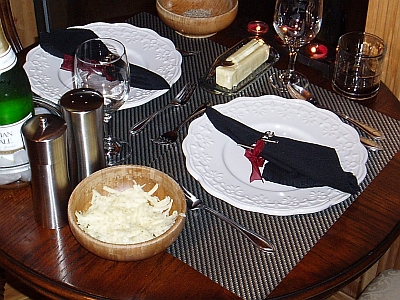 There are lots of things you need to know if you are planning to cook for someone who has celiac disease (also known as celiac/coeliac sprue). First of all, you are a kind friend, because you are willing to go out of your way to do a bit of research, and you are courageous enough to try some different recipes and new ingredients. Thank you for the invitation!
There are lots of things you need to know if you are planning to cook for someone who has celiac disease (also known as celiac/coeliac sprue). First of all, you are a kind friend, because you are willing to go out of your way to do a bit of research, and you are courageous enough to try some different recipes and new ingredients. Thank you for the invitation!
Some things to keep in mind. Celiac disease is a life-threatening inherited autoimmune condition that requires diligent removal of all gluten from the diet…even in microscopic amounts. Gluten is found in these grains: wheat, durum, semolina, barley, rye, spelt, kamut, and ordinary oats, which are often contaminated with wheat. You can buy gluten-free oats, but a small percentage of celiacs may have reactions to a protein found in oats–it’s controversial. Also, doctors sometimes put recently diagnosed celiacs on a special diet that requires them to avoid eggs or dairy, for example.
Your friends will thank you if you ask them if there is any ingredient, such as gluten-free oats, that you should avoid. And, it could be that they do not have celiac disease, but another form of gluten intolerance that restricts or allows different foods.
Cooking for someone with gluten intolerance requires care and thought beyond simple recipe substitutions. Think of your kitchen as a laboratory and keep the concept “contamination” foremost in your mind as you assemble ingredients and cook.
Let me explain. If you have a tub or stick of butter in your fridge and you dip a knife directly into it to spread on bread/toast or other glutenous foods, you now have a problem, because this butter might have crumbs in it so small they are invisible (the sniglet is “subatomic toasticles” : -) . Use a new stick of butter (or cut from the other end) or open a new container of butter spread. Do the same for any ingredient you did not open fresh for use in gluten free recipes and may have contaminated (for example, jams/jellies, sour cream, cream cheese, mayonnaise, and mustard).
Make sure all the pots, pans, utensils, and baking tins that you will use are very clean. Ensure that cutting boards are freshly scrubbed. If there will also be recipes made with wheat on the menu, be aware that this is risky. Make certain that those dishes are prepared separately and that you do not use the same utensils or knives, if they have not been well cleaned. This is especially important if you plan to have several pans going at once on the the stove and not all of them are gluten free. Please do not forget to tell your friend which dishes are not gluten free.
Of course, you cannot add wheat or any wheat containing ingredient to a dish that you intend to serve to a celiac. This includes the small amounts of flour that are sometimes used for thickening soups, stews, sauces, or gravies. Read ingredient labels carefully. Did you know that most soy sauces are made from about 50% soybeans and 50% wheat? Tamari sauces are a smoother and richer form of soy sauce derived mainly from soybeans with little or no wheat. I recommend San-J Tamari Sauce, which is certified GF by the Gluten Free Certification Organization; it is also non-GMO verified, certified organic, and certified kosher.
Keep things simple when planning your menu and serve mostly “naturally” gluten free items (fresh fruits, vegetables, meats, etc.) instead of buying unusual or exotic ingredients you may not need in the future. Then pull up your chair and enjoy the party!
This is very informative! Thanks a lot!
Many greetings from chilly Brussels! :)!!
Jean Ann, this is such a great way to express the care needed to cook for those with gluten issues! I love your recipes and should have let you know long ago that I use them. My husband has been diagnosed with celia sprue, and I consider myself to be “gluten sensitive”, so good recipes are appreciated. Your Tortola Granola is a particular favoite that I bake in muffin tins to make easily-transported rounds for us to carry to work.
Your tribute to your mother included with the pumpkin bread recipe is lovely and touching. I don’t know if she continued to use the grain mill I gave her to grind her wheat, but it had come to me from my grandfather after he died, and I was so glad to give it to her. If she used that one, she developed good arm muscles!
Keep up the good work, and thanks for sharing your expertise and knowledge!
Your Aunt Judy